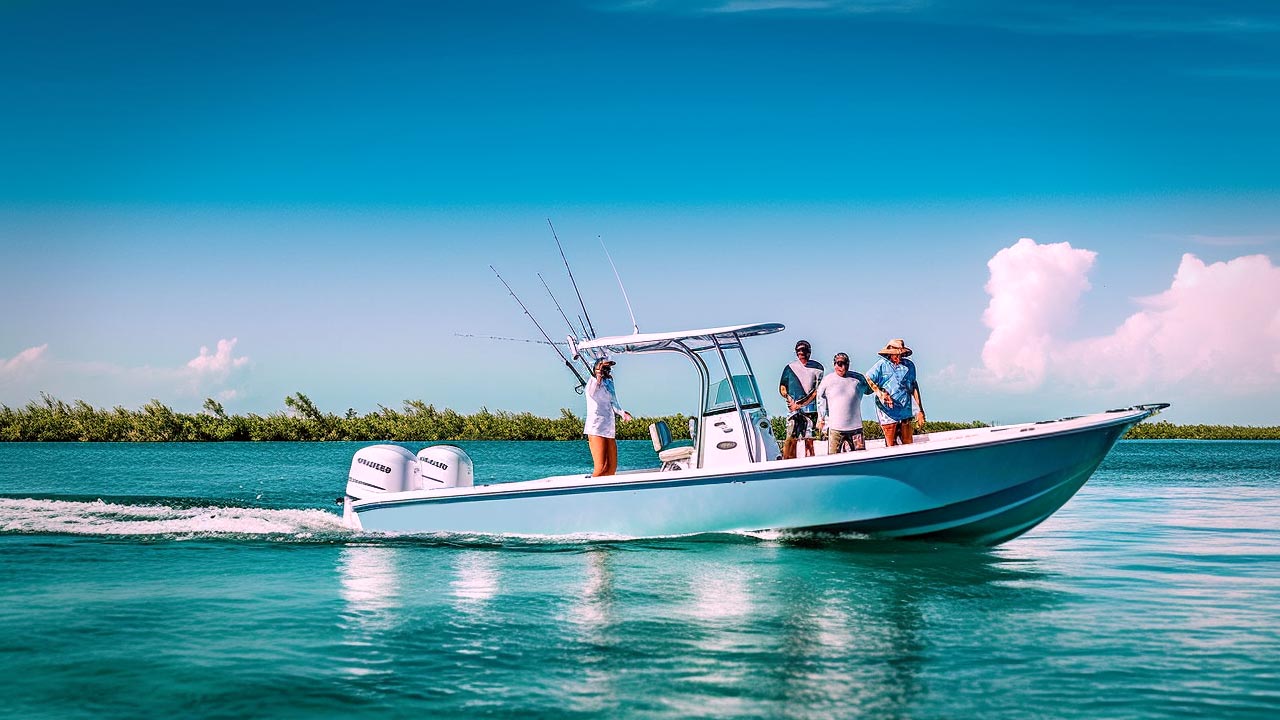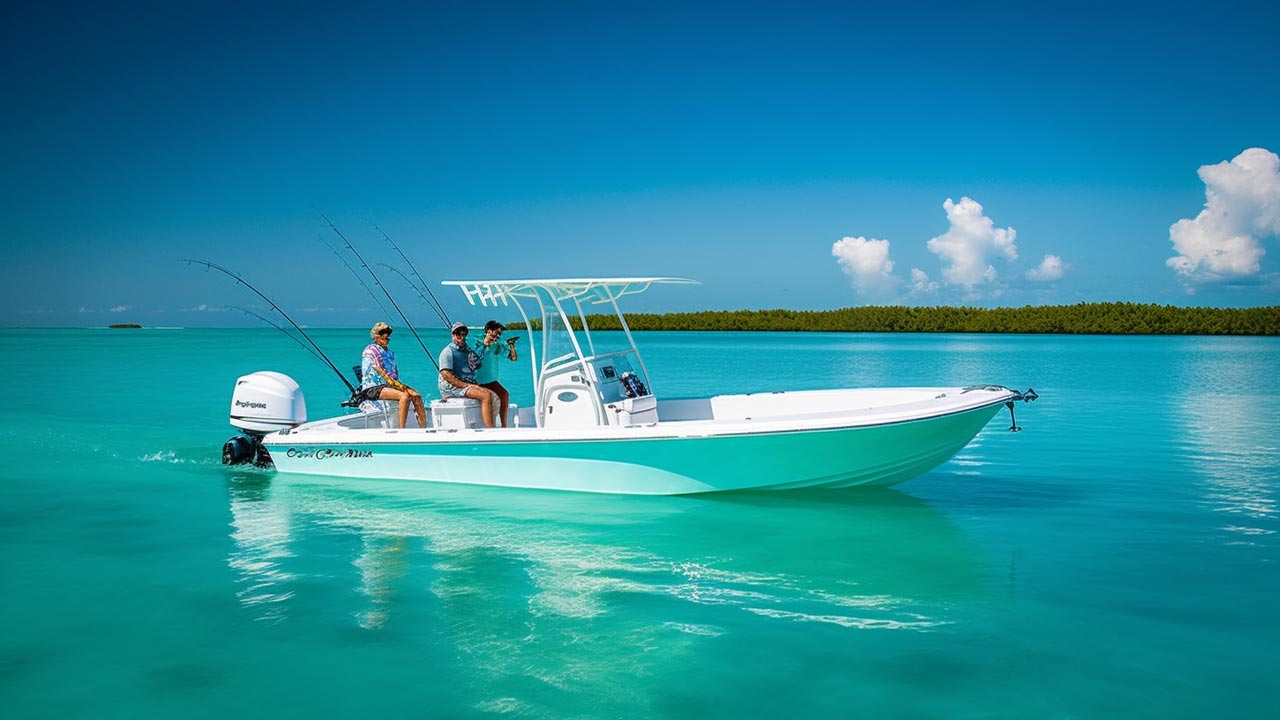A well-structured and traditional marketing plan is essential to compete effectively. This is as true for a fishing charter business as for any other enterprise. With the rise of digital technologies and social media, the marketing landscape has evolved to become more complex and dynamic. This article aims to provide a complete marketing plan for a fishing charter business in 2023, providing strategies and techniques that leverage both traditional and digital platforms to maximize your business’s potential.
Fishing charters offer a unique experience, combining the thrill of fishing with the beauty of the open waters. As such, the marketing strategies for these businesses must capture this unique selling proposition while also reaching out to the target audience effectively. The reader will learn how to develop a marketing plan that covers everything from market analysis, competitive analysis, identifying target customers, creating a unique selling proposition, leveraging digital and traditional marketing channels, and measuring marketing effectiveness.
The marketing plan shared in this article is actionable, with the goal of giving you the tools and knowledge needed to implement it in your fishing charter business. Whether you are starting from scratch or looking to refine your existing marketing plan, this guide will provide practical insights and strategies that are tailored to the fishing charter industry. By the end of this article, you should have a comprehensive understanding of how to create and execute a robust marketing plan that will help you attract more customers, increase sales, and grow your business.
Table of Contents
- Market Analysis
- Competitive Analysis
- Identifying Your Target Customer
- Creating a Unique Selling Proposition
- Leveraging Digital Marketing Channels
- Utilizing Traditional Marketing Channels
- Measuring Marketing Effectiveness
- Final Thoughts
- Sources
Market Analysis
Before you start marketing your fishing charter business, it’s essential to understand the market landscape. A thorough market analysis will help you identify trends, opportunities, and challenges in the fishing charter industry. It will give you a clearer picture of the industry’s current state and where it’s headed, allowing you to position your business strategically for growth and success.
Understanding the Size and Growth Trends in the Fishing Charter Market
Begin by examining the overall size of the fishing charter market. What is its current worth? Has it been growing or shrinking in recent years? What are the projected growth rates for the future? These are critical questions that will help you understand the potential for your business.
This information can be sourced from industry reports, government databases, and market research firms. It’s also beneficial to look at the number of fishing charter businesses currently operating. This can give you an idea of the market saturation and the level of competition you might face.
Identifying Key Market Drivers and Barriers
Next, you should identify the key drivers that influence the growth of the fishing charter market. These could include factors such as increased interest in recreational fishing, rising disposable income, or growth in tourism. Understanding these drivers can help you tap into the trends that will drive your business growth.
Conversely, it’s equally important to recognize any barriers or challenges that may impede market growth. This could be regulatory constraints, environmental concerns, or economic factors like a recession. Being aware of these barriers will allow you to devise strategies to overcome them or to mitigate their impact on your business.
Recognizing the Impact of Seasonality on the Business
Fishing charter businesses are often seasonal, with demand fluctuating throughout the year based on factors like weather, fish migration patterns, and vacation periods. Understanding these patterns is crucial for your marketing plan as it can inform your promotional activities, pricing strategies, and operational planning.
For example, during the peak season, you may want to increase your advertising spend to capitalize on the higher demand. During the off-season, you might offer discounts or special packages to attract customers. Additionally, understanding seasonality can help you manage your cash flow by anticipating periods of high and low income.
A thorough market analysis is the first step in creating an effective marketing plan for your fishing charter business. By understanding the size, trends, drivers, barriers, and seasonality of your market, you can make informed decisions and strategies that align with your market’s realities.
Competitive Analysis
Understanding your competition is crucial in any business, and a fishing charter business is no exception. A thorough competitive analysis allows you to understand your rivals’ strengths and weaknesses, providing insights into market trends and revealing opportunities for differentiation.

Identifying Your Direct and Indirect Competitors
Begin by identifying who your competitors are. Direct competitors are other fishing charter businesses that offer similar services in the same geographical area. Indirect competitors might include other forms of recreational or outdoor activities that potential customers could choose instead of a fishing charter.
To identify your competitors, you can use online resources such as Google Maps, review websites, tourism directories, and social media. You can also gain valuable insights from local knowledge, industry events, and networking with others in the industry.
Understanding Their Strengths and Weaknesses
Once you’ve identified your competitors, the next step is to analyze their strengths and weaknesses. This involves looking at various aspects of their business, such as their services, customer service, marketing strategies, pricing, reputation, and online presence.
For example, a competitor might have a strong online presence with a well-designed website and active social media channels. This could be a strength that helps them attract more customers. On the other hand, they might have negative customer reviews complaining about their service quality, which could be a potential weakness.
Understanding these aspects can help you identify areas where you can differentiate your fishing charter business and provide superior value to your customers.
Analyzing Their Marketing Strategies and Tactics
Finally, take a closer look at your competitors’ marketing strategies and tactics. How do they promote their services? What channels do they use? How do they position themselves in the market? What kind of messaging do they use in their communications?
Answering these questions can provide valuable insights into effective marketing strategies for your target market. It can also help you avoid strategies that are not working and identify gaps in the market that your competitors are not addressing.
However, while it’s important to learn from your competitors, it’s equally crucial to maintain your unique approach. Your goal should not be to copy your competitors but to understand the market better and find opportunities to set your business apart.
A thorough competitive analysis can provide valuable insights that inform your marketing strategy. It helps you understand the competitive landscape, identify opportunities for differentiation, and make informed decisions about how to position and promote your fishing charter business.
Identifying Your Target Customer
Knowing your target customer is a fundamental part of your marketing plan. Without a clear understanding of who you’re trying to reach, your marketing efforts could be wasted on people who aren’t interested in your services. Therefore, identifying your target customer allows you to focus your marketing resources efficiently and effectively.
Defining Your Ideal Customer
The first step in identifying your target customer is to define your ideal customer. This should be a detailed description of the type of person most likely to use your fishing charter service. You can start by considering demographic factors such as age, gender, income level, and location.
For instance, your ideal customer might be a male, aged 30-50, with a middle-to-high income level, who lives within a 100-mile radius of your location.
However, don’t stop at demographics. It’s also important to consider psychographic factors, such as interests, hobbies, lifestyle, and values. Your ideal customer might be someone who values outdoor activities, enjoys recreational fishing, and prefers active vacations over relaxing on a beach.
Understanding Their Needs, Preferences, and Behavior
Once you have a clear picture of your ideal customer, the next step is to understand their needs, preferences, and behavior.
What are their motivations for booking a fishing charter? Are they looking for a relaxing way to spend a day, a unique experience, or a way to catch fish they can’t find elsewhere? Understanding these needs can help you tailor your services and marketing messages to address these motivations.
Next, consider their preferences. Do they prefer to book online or over the phone? Do they rely on customer reviews when making a decision? Do they respond better to visual marketing materials or detailed descriptions?
Finally, examine their behavior. When do they typically book fishing charters? How far in advance do they plan? How do they find and research potential charters?
Segmenting Your Market for More Targeted Marketing
While it’s useful to have a single ideal customer in mind, in reality, your customer base will likely be more diverse. This is where market segmentation comes in.
Market segmentation involves dividing your broader target market into smaller, more homogeneous groups based on shared characteristics. For example, you might have one segment of customers who are experienced fishers and another segment who are novices looking for a guided experience.
Each segment will have different needs, preferences, and behaviors, and thus, might respond better to different marketing strategies. Segmenting your market allows you to tailor your marketing efforts to each segment, leading to more effective and efficient marketing.
Identifying your target customer is a critical step in creating an effective marketing plan for your fishing charter business. By understanding who your customers are, what they need, and how they behave, you can create targeted marketing strategies that resonate with them and lead to higher engagement and conversions.

Creating a Unique Selling Proposition
In a competitive industry like fishing charters, it’s essential to differentiate your business from others. One effective way to do this is by creating a unique selling proposition (USP). A USP is a clear statement that describes the unique value your business offers, how it solves your customers’ needs, and what sets it apart from the competition.
Identifying Your Unique Attributes
The first step in creating a USP is to identify what makes your fishing charter business unique. This could be anything from your years of experience, your specialized knowledge of local fishing spots, the quality of your equipment, or the personalized service you provide.
Think about the things that your customers compliment or remember about your business. Ask yourself why your loyal customers choose you over your competitors. These could all be potential unique attributes that you can highlight in your USP.
Understanding What Your Customers Value
While it’s important to identify what makes you unique, it’s equally critical to ensure that these unique attributes are things that your customers value.
For instance, you might pride yourself on having the most advanced fishing equipment, but if your target customers are novices who don’t know or care about the latest fishing gear, this might not be a strong selling point.
Therefore, always keep your target customer in mind when identifying your unique attributes. Your USP should highlight the unique value you provide that meets your customers’ needs or solves their problems.
Crafting Your USP Statement
Once you’ve identified your unique attributes and ensured they align with your customers’ values, the next step is to craft your USP statement. This should be a concise, clear statement that encapsulates the unique value you provide.
Here’s an example: “Experience the thrill of deep-sea fishing with Captain John’s Charters. Our seasoned guides, intimate knowledge of local waters, and top-tier equipment make for an unforgettable fishing adventure.”
Incorporating Your USP into Your Marketing
Finally, your USP should be a cornerstone of your marketing. It should be featured prominently on your website, social media profiles, advertising materials, and any other customer touchpoints.
Every aspect of your marketing should reinforce your USP. For instance, if your USP is your experienced guides, your marketing materials might feature stories or testimonials from your guides, photos of them in action, or content they’ve created about fishing.
In conclusion, a compelling USP can set your fishing charter business apart from the competition, attract your target customers, and give them a clear reason to choose you. It’s a critical component of your marketing strategy that can drive the success of your business.
Leveraging Digital Marketing Channels
In today’s digital age, leveraging digital marketing channels is no longer optional, but a must for businesses in virtually every industry, including the fishing charter business. Here’s how you can effectively use various digital marketing channels to reach your target customers, increase your visibility, and grow your business.
Website
Your website is often the first point of contact between you and potential customers. Therefore, it’s crucial to have a professionally designed, easy-to-navigate website that clearly communicates your unique selling proposition and the services you offer.
Your website should also be optimized for search engines (SEO) to increase your visibility on search results. This involves using relevant keywords, creating high-quality content, and ensuring your site is fast and mobile-friendly.
Additionally, consider adding a booking system to your website, allowing customers to easily book a charter without having to call or email. This can greatly improve the user experience and increase conversion rates.
Social Media
Platforms like Facebook, Instagram, and YouTube are powerful tools for promoting your fishing charter business. They allow you to engage with your audience, share engaging content, and build a community around your brand.
Consider sharing photos and videos from your charters, customer testimonials, fishing tips, and information about local fish species and fishing spots. Don’t forget to engage with your followers by responding to comments and messages, and consider running contests or giveaways to increase engagement.
Email Marketing
Email marketing is an effective way to keep in touch with your customers, share news and updates, and promote your services.
Start by building an email list of people who have expressed interest in your services or have booked a charter with you in the past. Then, send regular newsletters that provide value to your subscribers, such as fishing tips, special offers, or updates about your charters.
Remember to keep your emails engaging and not overly promotional. The goal is to build a relationship with your subscribers and keep your business top of mind, not to hard sell them on every communication.
Online Advertising
Online advertising through platforms like Google Ads or Facebook Ads can be a powerful way to reach your target customers. You can target your ads based on various factors such as location, demographics, interests, and behavior, ensuring your ads are seen by people who are most likely to be interested in your services.
Leveraging digital marketing channels can greatly enhance your visibility, reach your target customers, and grow your fishing charter business. Each channel has its strengths and can be an integral part of a well-rounded, effective marketing strategy.
Utilizing Traditional Marketing Channels
While digital marketing is increasingly important, traditional marketing channels continue to be effective for many businesses, including fishing charter businesses. Here’s how you can leverage these channels to reach your target customers and promote your business.
Print Advertising
Print advertising includes placing ads in newspapers, magazines, brochures, and other printed materials. For a fishing charter business, consider advertising in local tourist guides, outdoor recreation magazines, or local newspapers.
The key to effective print advertising is to have a clear, engaging message, a strong call to action, and an attractive design. Also, make sure to choose publications that are read by your target customers.
Direct Mail
Direct mail involves sending promotional materials directly to potential customers. This could include postcards, brochures, or letters.
One strategy is to send direct mail to people who have previously booked a charter with you, offering them a discount on their next booking. This can be an effective way to encourage repeat business.
Outdoor Advertising
Outdoor advertising includes billboards, posters, and signage. For a fishing charter business, signage at your dock or office is crucial. You might also consider billboards or posters in high-traffic areas, such as tourist centers, airports, or popular restaurants.
Networking and Word-of-Mouth Marketing
Networking can be a powerful way to spread the word about your business. This can involve attending industry events, joining local business associations, or simply building relationships with other business owners in your area.
Word-of-mouth marketing, meanwhile, is about encouraging your customers to recommend your business to others. This can be achieved by providing excellent service, asking for referrals, or offering incentives for referrals.
Partnerships and Collaborations
Partnerships and collaborations with other businesses can be an effective way to reach more potential customers. For instance, you might partner with a local hotel or tourist agency to offer package deals that include a fishing charter.
While digital marketing is crucial in today’s world, traditional marketing channels can still play an important role in your marketing strategy. By combining both digital and traditional marketing channels, you can reach a wider audience and effectively promote your fishing charter business.
Measuring Marketing Effectiveness
Effective marketing is not just about implementing strategies but also about evaluating their effectiveness. By measuring your marketing efforts, you can determine what’s working, what’s not, and make data-driven decisions to improve your marketing. Here are some key ways to measure the effectiveness of your marketing for your fishing charter business.
Set Clear, Measurable Goals
Before you can measure your marketing effectiveness, you need to know what you’re aiming for. Set clear, measurable goals for your marketing efforts. These might include increasing website traffic, growing your social media following, increasing booking rates, or improving customer retention.
Each marketing channel you use should have its own set of goals. For example, your goal for email marketing might be to increase your open and click-through rates, while your goal for social media marketing might be to increase engagement and gain more followers.
Use Key Performance Indicators (KPIs)
Key Performance Indicators (KPIs) are metrics that measure how well you’re achieving your goals. For instance, if your goal is to increase website traffic, your KPI might be the number of unique visitors to your website.
Choose KPIs that are relevant to your goals and that provide meaningful insights into your marketing performance. Some common marketing KPIs include click-through rates, conversion rates, customer acquisition costs, customer lifetime value, and return on investment (ROI).
Use Analytics Tools
To track your KPIs, you’ll need to use analytics tools. Google Analytics is a powerful tool for tracking website traffic, user behavior, and conversions. Social media platforms also typically have built-in analytics tools that provide insights into your followers, post performance, and engagement.
For email marketing, most email marketing platforms provide analytics on open rates, click-through rates, and conversions. And for your overall business performance, you can use a customer relationship management (CRM) system to track bookings, revenue, and customer retention.
Regularly Review and Adjust Your Strategies
Finally, it’s important to regularly review your marketing performance and adjust your strategies as needed. If a particular strategy isn’t achieving the desired results, don’t be afraid to tweak it or try something new.
Remember, marketing is an ongoing process of trial and error. What works for one business might not work for another, and what works today might not work tomorrow. The key is to stay flexible, keep learning, and continuously strive to improve.
In conclusion, measuring your marketing effectiveness is a crucial part of your marketing plan. By setting clear goals, tracking relevant KPIs, utilizing analytics tools, and regularly reviewing and adjusting your strategies, you can ensure your marketing efforts are driving your fishing charter business towards success.
Final Thoughts
The most important takeaway from this article is the understanding that marketing a fishing charter business in 2023 involves a comprehensive, multi-faceted approach. A successful marketing plan requires a deep understanding of the market, competition, and your target customer. It requires creating a compelling unique selling proposition and effectively leveraging both digital and traditional marketing channels. However, the execution of these strategies is not a set-it-and-forget-it endeavor. Instead, continuous monitoring, measuring, and adjusting your strategies based on the data you gather is crucial to ensure ongoing success.
Marketing is a dynamic and ongoing process. The market, technology, and customer behaviors are constantly changing. Therefore, your marketing strategies need to be flexible and adaptable. Stay updated with the latest trends, technologies, and customer preferences to keep your fishing charter business ahead of the competition.
Sources
- “The Ultimate Guide to Small Business Marketing”
- “Digital Marketing for Small Businesses”
- “How to Conduct a Market Analysis for Your Business”
- “Understanding Your Competition”
- “How to Identify Your Target Market”
- “Creating a Unique Selling Proposition”
- “Measuring Marketing Effectiveness: 6 Metrics You Need to Track”











Leave A Comment